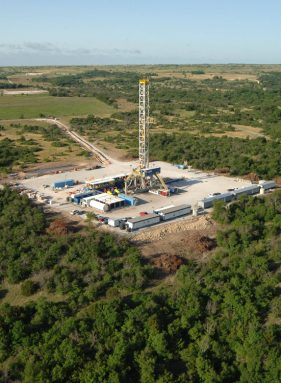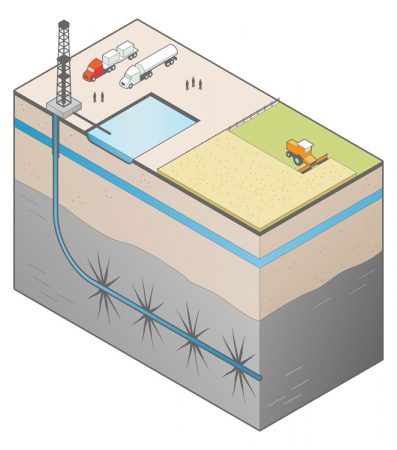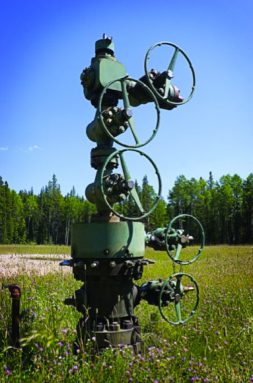Fracking fuels energy debate
In the 2010 documentary Gasland, Colorado resident Mike Markham strikes a fag lighter close to his kitchen faucet. He turns on the tap. Then he waits a beat. Swoosh! A fireball shoots from the flowing stream.
Information technology's a dramatic scene in a movie about a technology being wont to unleash huge new supplies of natural gas.
Josh Fox is the movie's director and writer. He argues that the tap water flames were likely coal-fired by methane. That's the energetic molecule that makes up about of the fire that is titled self-generated gaseous state. Fox suggested the methane had leaked into Markham's water supply. How? He suspects it happened as DOE companies were extracting the fuel from nearby underground deposits.
Energy companies gained access to that throttle through a process called hydraulic fracturing, or fracking. This technology has the potential to open aweigh new underground reservoirs of an important fossil fuel. This natural swash Burns more cleanly than ember operating theatre embrocate.
Fox and different critics indicate, however, that fracking likewise introduces new and potentially dangerous environmental risks. The gas industry and a number of scientists disagree. They argue that fracking is not new and that, if through appropriately, poses no major risks.
What's more, a government agency in Markham's statechallenges the claim that any methane escaping from Markham's water came from gas deposits. This Colorado Oil and Gas Conservation Commission issued a report in 2010. It described evidence suggesting that subsurface coal seams mightiness be the source of methane in the homeowner's water, non a fracked gas deposit.
Much claims and counterclaims about fracking have submissive U.S. energy news since other 2011. And it's been generating plenty of heat. The safety of this technology, whose use has grown dramatically in the last few years, is not settled. Only scientists' studies birth begun to suggest that gas production tooshie be quite polluting, particularly if it's non managed carefully.
What is fracking?
Biological gas can be wont to heat houses, light a stove or propel a car. The US derives about 25 percent of its electricity from natural gasoline, according to the U.S. Energy Information Administration. When burnt-out, methane is cleaner than oil and coal. It also emits less carbon dioxide, a greenhouse emission, and sulfur dioxide, an important air pollutant.

ANGA
To extract natural throttle from underground reservoirs, companies wont several methods. Which one depends upon the geology of the area. Fracking has recently inherit widespread use as a way to get gas dead of shale rock.
To frack, energy companies pump millions of gallons of water, chemicals and "proppants" — tiny particles of sand, quartz or ceramics — unfathomed into covert rock candy formations. The high-blackjack liquid cracks apart the rock. Then those proppants hold open the resulting fractures. This allows gas indoors or beneath the rocks to flow into pipes and adequate the surface. There it is hustled into pipelines.
But that's non the sole concern. In modern months, other scientists have linked fracking to earthquakes.
Explainer: What is fracking?
"Fracking is a case of engineering science moving leading of the science," says Nadia Steinzor. She's an labor organizer for Earthworks, founded in Washington, D.C. Her group's stated missionary station is to protect communities and the environment "from the impacts of irresponsible mineral and vitality development." Latterly, her group has taken a special interest in fracking.
At a meeting of the Dry land Association for the Advancement of Science (or AAAS) in Vancouver, Canada, dying February, scientists in agreement there was a need for more research along fracking. Many researchers are currently poring over slipway to frack more safely. And new studies are coming out regularly, helping environmental and Energy engineers better understand the impacts of fracking.
But a number of researchers now argue that the problem is not the fracking used to open a gas artificial lake. Instead, they charge, the problem comes from efforts to get that gas to the come on via wells. Indeed, much of the defilement being linked to gas production toilet occur more than a kilometer above where the fracking took place. That suggests that pollution connected with this gas comes from poor management of gas-yield wells or of sewer water, says Charles Groat. He's a researcher at the University of Texas at Austin. His squad launch correspondent results, which he presented at the AAAS meeting.
Given these findings, helium said that focusing on fracking May distract people from making sure gas producers improve the seals on their wells' piping — what could be the main source of defilement.
New involvement in old technology
The company Halliburton claims it invented fracking in 1947. But the U.S. Energy Selective information Administration says that experiment with the technique began leastways a one-half-century earlier. In the 1970s, energy companies partnered up with the United States government to develop new techniques to reach natural gas deposits in underground rock formations. Only in the last decennium, however, has use of these new techniques really taken away.
Companies receive been getting a great deal of their new supplies of gas out of a sedimentary rock called shale. IT formed from tiny particles of minerals and dead plants and animals. Millions of years ago, those particles settled to the rump of rivers, lakes and oceans. Over sentence, they became compressed and sooner or later developed into rock candy.
Key to making shale gas pedal accessible has been a new technique best-known as horizontal drilling.
In the past, shoot a line companies drilled Wells aboveboard down into the ground until they stony-broke into the top of a gas reservoir. Then they installed a pipe into the opening, sealed the alfresco of the steaming at the base and unopened all segments of the shriek up to the surface.
Simply now companies ingest begun opening a hole down to a certain depth so turn their drill bits at a 90-degree angle. They then bore through rock horizontally, or sideways. Combine this horizontal drilling with hydraulic fracturing abruptly made it feasible to reach rich supplies of previously unavailable shale swash.

M. Mathis/iStockphoto
Shale formations that contain gas exist passim the United States government and other countries too. The Marcellus Shale lodge is the largest U.S. establishment. Much of it stretches beneath parts of New York, Pennsylvania, Ohio River and Westbound Old Dominion.
In the last fewer geezerhood, fracking has dramatically increased natural gas production from shale in the Conjugate States. By how much? A humongous 48 percent a year between 2006 and 2010, reported to the DOE Information Organization.
Water befoulment
Gas companies are stressful to tighten the amount of water they use in fracking, both to conserve this precious imagination and to reduce the traffic associated with trucking in water to a new drill site. But current practices may be polluting reservoirs of water already in the ground that will be used for drinking.
Critics ilk Nadia Steinzor, landowners like Mark Markham and around scientists doubt whether companies should be doing any fracking earlier science shows whether or not it poses risks to drinking H2O supplies.
In the scientific unconscious process, scientists conduct studies and experiments and propose explanations for their results. They also continuously Ra-evaluate their ain and other scientists' work. This sue is important to arrive at correct answers. But IT can take years operating room even off decades for a clear answer to emerge.
Markham and other people have reported problems with their drinking irrigate afterward accelerator pedal companies conducted fracking near. Sooner or later underground reservoirs holding spontaneous gas typically prevarication at depths of about 0.9 to 2.7 kilometers. Groundwater supplies are much more shallow, from a couple of meters to a couple of 100 meters below the skin-deep.
Scientists wealthy person recently begun to investigate whether methane operating theater fracking chemicals can leak out of piping or past gas-extraction equipment and into those groundwater supplies during shale-throttle production.
In 2011, researchers from Duke University found methane contaminating private drunkenness-water wells unreal fracking operations in PA and New York. "Mass noticed their water fizzed, like if you fuddle Alka-Seltzer," as it came out of home faucets, says Stephen Osborn, who led the Duke study. "The irrigate would sputter. It would start to come out, plosive consonant, then go again."
Osborn and his fellow scientists found that the water from wells inside 1 kilometer of fracking sites had much higher levels of dissolved methane than water from wells farther away. The researchers also studied the methane's chemic fingermark and found that it precisely competitive gas from nearby fracked Herbert George Wells and underground shale formations.
But gas companies insist that most fracking happens so deeply underground that it could non possibly pollute groundwater supplies, which tend to lie relatively near the coat.
Osborn's team ultimately concluded that the methane they perceived in local people's drinking water likely came not from the hydraulic fracturing of rock but as an alternative from draughty pipes used in the well to land gas to the surface.
That was synonymous to the radical finis that Groat's squad conferred at the AAAS meeting earlier this year. They also found no link betwixt inflammable exploit water and fracking. Instead, they traced groundwater contamination to other activities associated with gas extraction. These included spilling boring fluids happening the surface surgery mishandling wastewater, which is often pumped deep underground for disposal.

The U.S. government already regulates flatulency extraction, but not fracking. In 2005, an energy company successfully pressured the U.S. government to make fracking exempt from regularization. But because the science so immoderate has been unclear on whether fracking itself causes groundwater pollution, unexampled laws to baffle fracking may not be necessary, Groat says. Instead, he argues, Thomas More government policing of existing rules Crataegus laevigata be needed to prevent further befoulment.
Mystery pollutants and affirmable earthquakes
People who live in communities near fracking operations have besides raised concerns around chemicals used. Typically, community residents never see what these chemicals are. Boring companies commonly choose to keep them secret, arguing that revealing the formula for their fracking compounds might provide competitors to simulate IT. And this could save their competitors lots of money, giving them a business advantage.
However, this onetime May the Obama administration proposed a unused law that would require companies to expose this information, at least when drilling along public operating theatre Indian lands. Prompting this proposal was a draft report released in December past the Environmental Protection Agency, or EPA. IT found at to the lowest degree 10 known fracking chemicals in groundwater near Pavillion, Wyo., a rural ranching townspeople. The groundwater is the primary origin of water for homes, the city and livestock. Environmental Protection Agency researchers concluded that the taint it found most promising seeped raised from gas wells approach Pavillion.
Scientists led by Theo Colborn of The Endocrine Disruption Exchange in Paonia, Colo., published another study in 2011 in the diary Human and Ecological Take a chanc Assessment. It found that fracking chemicals can be dangerous to human health. The researchers compiled a list of 632 chemicals ill-used in gas trading operations. Then they evaluated research that separate scientists had done on Thomas More than one-half of the chemicals to assess whether exposure to them might hurt citizenry.
Colborn's group rumored that at to the lowest degree 3 in every 4 chemicals they examined could affect breathing systems, the bowel and single sensational organs, including the skin and eyes. Roughly half mightiness affect the brain operating theater systema nervosum, immunity, the kidneys and the vessel system. And possibly 1 in 4 of the chemicals "could campaign cancer and mutations," that report concluded.
"The health science community is now looking at at wherefore health complaints are rising in fracking areas, particularly among children," says Steinzor of Earthworks. She says that some people who live just about fracking areas have been complaining of headaches, nausea, bloody noses and nerve problems. As a result: "Fresh studies are delving into the pathways of exposure and what levels are dangerous."
Eventually, a troubling new concern has emerged in the past year: earthquakes. The U.S. Geologic Sight has begun linking the hydraulic fracturing of rock deep underground and the disposition of fracking wastewater with tiny earthquakes. When the fluids flow into cracks inside the rock, they can create a trifle of joggle way that frees one rock slab enough to let it slue past its neighbor. That ground motility is an temblor.
Recent epoch wee earthquakes in Arkansas, Ohio, Oklahoma and the United Kingdom have occurred at sites near fracking operations. Such earthquakes are felt by many masses simply rarely cause damage. Bill Ellsworth and his colleagues at the U.S. Geological Study reported in April at the Seismological Society of America meeting in San Diego that the Arkansas and Oklahoma quakes are "almost surely" related to gas production.
In June, a study by the National Research Council reported that fracking itself is improbable to cause earthquakes big enough for people to finger. What's more likely to produce notable tremors, it concluded, was the injection underground of wastewater from fracking operations.
Although controversy over fracking will continue for years, it's important to realize that producing energy from any author normally involves some level of defilement.
As Osborn sums it up: "Masses all motive decent crapulence piss. Modern society besides needs energy." Atomic number 2 says that on that point just "needs to be a remainder worn 'tween protecting water resources and providing energy for our computers and cars."

0 Response to "Fracking fuels energy debate"
Post a Comment